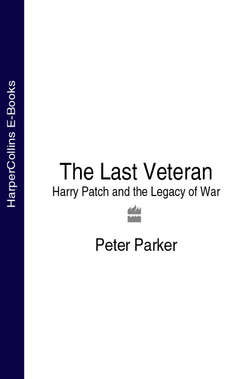The Last Veteran: Harry Patch and the Legacy of War

Реклама. ООО «ЛитРес», ИНН: 7719571260.
Оглавление
Peter Parker. The Last Veteran: Harry Patch and the Legacy of War
COPYRIGHT
DEDICATION
CONTENTS
PROLOGUE
ONE
TWO
INTERLUDE
THREE
FOUR
FOOTNOTES
BIBLIOGRAPHY
INDEX
SOURCE NOTES
ACKNOWLEDGEMENTS
ABOUT THE AUTHOR
PRAISE
ALSO BY THE AUTHOR
Отрывок из книги
For my godson Julius Lunn
– next generation –
.....
Regardless of the historical and demographic facts, when remembering the First World War the British continue to talk about a lost generation. There is a sense that as a nation we have never quite recovered from this loss, that the flower of British youth was cut down in Picardy and Flanders, that an irreplaceable wealth of talent and an almost prelapsarian state of innocence were destroyed for ever between the years 1914 and 1918. Cast out of the Edwardian Eden, where it was somehow always perfect summer weather, we have ever after tended to look yearningly back rather than expectantly forward.
The war has become part of who we are. It occupies a disproportionately large place in our sense of the world and its history and remains a seemingly endless resource not only for historians, but for novelists, poets, dramatists and composers, for cinema and television. The sounds and images of the war are so imprinted on the national consciousness that we recognise them instantly: the foreign place names such as Mons, Ypres, Loos, Passchendaele and the Somme, which retain a familiarity even for those who could not point to them on a map; the lines of men at the recruiting offices on 4 August 1914 and the rows of crosses (now replaced by rounded headstones) that marked where those bank-holiday crowds ended up; the scarlet poppies blowing in a landscape rendered unrecognisable by shellfire; the mud and the blood, and the big guns in France that could be heard this side of the Channel. When in 1980 Kenneth Macmillan created a ballet using Poulenc’s Gloria, all he had to do was place tin helmets on the dancers’ heads to make this joyous piece of music into a requiem. Indeed, the war is constantly used – some might say dragged in – as a reference point in the arts: Andrew Davies’s television adaptation of A Room with a View (2007) dispensed with E.M. Forster’s happy ending and had George Emerson killed in the trenches, while Kenneth Branagh’s film of Mozart’s The Magic Flute (2006) sent Tamino off to the Somme. The complex philosophical ideas, with their Masonic elements, that characterise the struggle between Sarastro and the Queen of the Night in The Magic Flute could, Branagh felt, be presented to a wider audience if the action was moved to the Western Front. ‘By giving each an army and presenting visually the landscape of the First World War, there is a sense of import and scale about the actions of these characters,’ he said. ‘The Great War provides a territory both literal and metaphoric that is as emotive and complex as the opera itself.’
.....